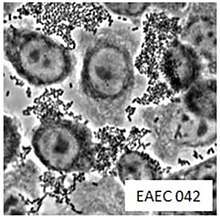Enteroaggregative ''Escherichia coli''

Enteroaggregative Escherichia coli (EAEC or EAggEC) are a pathotype of Escherichia coli associated with acute and chronic diarrhea in both the developed and developing world.[1][2] EAEC are defined by their "stacked-brick" pattern of adhesion to the human laryngeal epithelial cell line HEp-2.[3] The pathogenesis of EAEC involves the aggregation of and adherence of the bacteria to the intestinal mucosa, where they elaborate enterotoxins and cytotoxins that damage host cells and induce inflammation that results in diarrhea.
EAEC is now recognized as an emerging enteric pathogen. In particular, EAEC are reported as the second most common cause of traveler's diarrhea, second only to Enterotoxigenic E. coli, and a common cause of diarrhea amongst pediatric populations.[4][5] It has also been associated with chronic infections in the latter, as well as in immunocompromised hosts, such as HIV-infected individuals.[6] Awareness of EAEC was increased by a serious outbreak in Germany during 2011, causing over 5000 cases and at least 50 fatalities. The pathogen responsible was found to be an EAEC O104:H4 strain which was lysogenized by a Shiga toxin encoding phage (typically associated with Shiga toxin-producing Escherichia coli, which often encode the adhesin intimin).[7][8] The putative cause of the outbreak were sprouted fenugreek seeds.[9]
Strains of EAEC are highly genetically heterogeneous, and the identification of virulence factors important for pathogenesis has proven difficult.[10] Many EAEC encode a transcriptional factor named aggR (aggregative regulator), part of the AraC family of transcription activators. AggR regulates many plasmid, as well chromosomally encoded, virulence factors, that include genes implicated in aggregative adherence fimbriae biogenesis and toxin production. Several toxins have been linked to EAEC virulence, including ShET1 (Shigella enterotoxin 1), Pet (plasmid‐encoded toxin), and EAST-1. However, further studies of these factors have failed to elucidate their role in pathogenesis.[11]
More recently, a study of symptomatic children in Mali has led to increased interest in specific sets of EAEC virulence factors. The study utilized Classification and Regression Tree analysis, or CART analysis, to identify sets of EAEC factors which were implicated in virulence amongst pediatric patients who presented with acute diarrhea. The researchers found that a subset which encoded the gene for the cryptic serine protease SepA, previously described in Shigella, and lacking the transcriptional regulator of hemolysin expression, rmoA were associated with virulence. Furthermore, a set of EAEC which encoded the flagellar antigen H33 and the EAST-1 toxin were associated with diarrhea. These results and more recent efforts have suggested that a specific set of virulence determinants may be more important in pathogenesis of EAEC than the presence or absence of singular virulence factors.[12]
References
- ↑ Nataro, J. P.; Mai, V.; Johnson, J.; Blackwelder, W. C.; Heimer, R.; Tirrell, S.; Edberg, S. C.; Braden, C. R.; Morris, J. G. (2006-08-15). "Diarrheagenic Escherichia coli Infection in Baltimore, Maryland, and New Haven, Connecticut". Clinical Infectious Diseases. 43 (4): 402–407. doi:10.1086/505867. ISSN 1058-4838.
- ↑ Hebbelstrup Jensen, Betina; Olsen, Katharina E. P.; Struve, Carsten; Krogfelt, Karen Angeliki; Petersen, Andreas Munk (2017-02-03). "Epidemiology and Clinical Manifestations of Enteroaggregative Escherichia coli". Clinical Microbiology Reviews. 27 (3): 614–630. doi:10.1128/CMR.00112-13. ISSN 0893-8512. PMC 4135892. PMID 24982324.
- ↑ Nataro, J. P.; Kaper, J. B.; Robins-Browne, R.; Prado, V.; Vial, P.; Levine, M. M. (1987-09-01). "Patterns of adherence of diarrheagenic Escherichia coli to HEp-2 cells". The Pediatric Infectious Disease Journal. 6 (9): 829–831. doi:10.1097/00006454-198709000-00008. ISSN 0891-3668. PMID 3313248.
- ↑ Huang, David B.; Mohanty, Alakananda; DuPont, Herbert L.; Okhuysen, Pablo C.; Chiang, Tom (2006-10-01). "A review of an emerging enteric pathogen: enteroaggregative Escherichia coli". Journal of Medical Microbiology. 55 (Pt 10): 1303–1311. doi:10.1099/jmm.0.46674-0. ISSN 0022-2615. PMID 17005776.
- ↑ Adachi JA, Jiang ZD, Mathewson JJ, Verenkar MP, Thompson S, Martinez-Sandoval F, Steffen R, Ericsson CD, DuPont HL (2001). "Enteroaggregative Escherichia coli as a Major Etiologic Agent in Traveler's Diarrhea in 3 Regions of the World" (PDF). Clin Infect Dis. 32 (12): 1706–9. doi:10.1086/320756. PMID 11360211.
- ↑ Huang, D. B.; et al. (2006). "A review of an emerging enteric pathogen: enteroaggregative Escherichia coli". Journal of Medical Microbiology. 55 (10): 1303–1311. doi:10.1099/jmm.0.46674-0. PMID 17005776.
- ↑ Kalita, Anjana; Hu, Jia; Torres, Alfredo G. (2017-02-01). "Recent advances in adherence and invasion of pathogenic Escherichia coli". Current Opinion in Infectious Diseases. 27 (5): 459–464. doi:10.1097/QCO.0000000000000092. ISSN 0951-7375. PMC 4169667. PMID 25023740.
- ↑ Nadia Boisen; Angela R. Melton-Celsa; Flemming Scheutz; Alison D. O'Brien; James P. Nataro (2015). "Shiga toxin 2a and Enteroaggregative Escherichia coli—a deadly combination". Gut Microbes. 6 (4): 272–278. doi:10.1080/19490976.2015.1054591. PMC 4615819. PMID 26039753.
- ↑ "Outbreak of Escherichia coli O104:H4 Infections Associated with Sprout Consumption — Europe and North America, May–July 2011". www.cdc.gov. Retrieved 2017-02-01.
- ↑ Harrington, Susan M.; Dudley, Edward G.; Nataro, James P. (2006-01-01). "Pathogenesis of enteroaggregative Escherichia coli infection". FEMS Microbiology Letters. 254 (1): 12–18. doi:10.1111/j.1574-6968.2005.00005.x. ISSN 1574-6968.
- ↑ Ruan, Xiaosai; Crupper, Scott S.; Schultz, Bruce D.; Robertson, Donald C.; Zhang, Weiping (2012-08-15). "Escherichia coli Expressing EAST1 Toxin Did Not Cause an Increase of cAMP or cGMP Levels in Cells, and No Diarrhea in 5-Day Old Gnotobiotic Pigs". PLOS ONE. 7 (8): e43203. doi:10.1371/journal.pone.0043203. ISSN 1932-6203. PMC 3419656. PMID 22905235.
- ↑ Boisen, Nadia; Scheutz, Flemming; Rasko, David A.; Redman, Julia C.; Persson, Søren; Simon, Jakub; Kotloff, Karen L.; Levine, Myron M.; Sow, Samba (2012-02-01). "Genomic Characterization of Enteroaggregative Escherichia coli From Children in Mali". The Journal of Infectious Diseases. 205 (3): 431–444. doi:10.1093/infdis/jir757. ISSN 0022-1899. PMC 3256949. PMID 22184729.